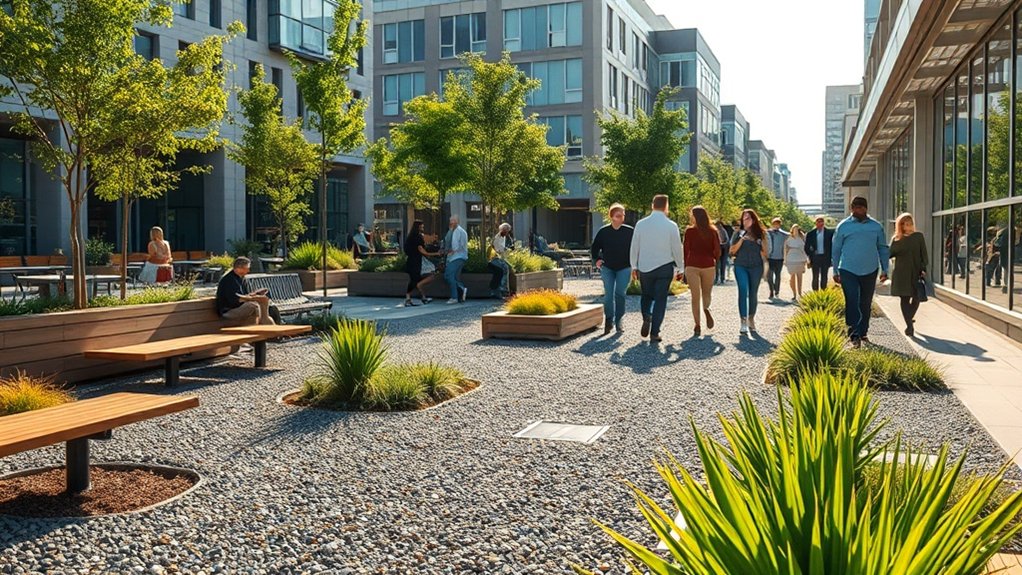Resin-bound gravel merges beauty with sustainability in urban planning. It aids rainwater harvesting, meets SUDS regulations, and boasts excellent drainage capabilities. With minimal upkeep and a lifespan of 20 to 30 years, it withstands UV rays and harsh weather. Its adaptable design not only enhances visual appeal but also reduces slip hazards, ensuring safety. This versatile material encourages community involvement and supports environmentally friendly practices. Discover how resin-bound gravel can benefit modern urban spaces.
Key Takeaways
Resin-bound gravel is an excellent choice for sustainable urban planning in the UK. It helps manage water effectively, meeting SUDS regulations and improving rainwater harvesting.
Its durability and low-maintenance requirements mean less long-term expenditure for local councils. The material also offers aesthetic versatility, making it easy to blend into various urban designs, which enhances the visual appeal of neighbourhoods.
The permeable nature of resin-bound gravel reduces surface runoff and pollution, promoting groundwater recharge and natural drainage. Additionally, creating attractive public spaces encourages community engagement, supports local businesses, and increases property values.
Environmental Sustainability Features
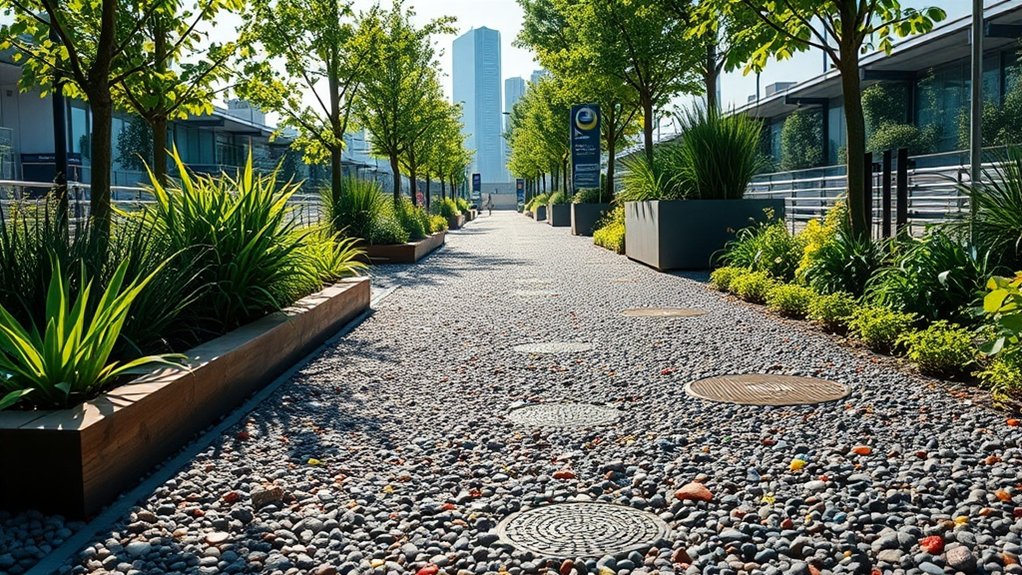
As urban planners focus more on sustainability, resin-bound gravel stands out as an effective solution to various environmental issues. Its permeability allows for efficient rainwater harvesting, which aids natural drainage and reduces stormwater runoff. This helps replenish groundwater, supporting ecological restoration and lowering flood risks. Resin-bound gravel also complies with UK SUDS regulations, ensuring effective water management in urban environments.
Compliance with Sustainable Urban Drainage Systems (SUDS) regulations ensures effective water management. Moreover, resin-bound gravel is highly recyclable—up to 80%—which promotes a closed-loop system and significantly reduces waste. Its modular design also allows for easy partial replacements, cutting down on resource use and landfill contributions. The use of recycled materials in its composition further enhances its eco-friendly profile, making it a smart choice for sustainable urban planning.
Urban Design and Aesthetics
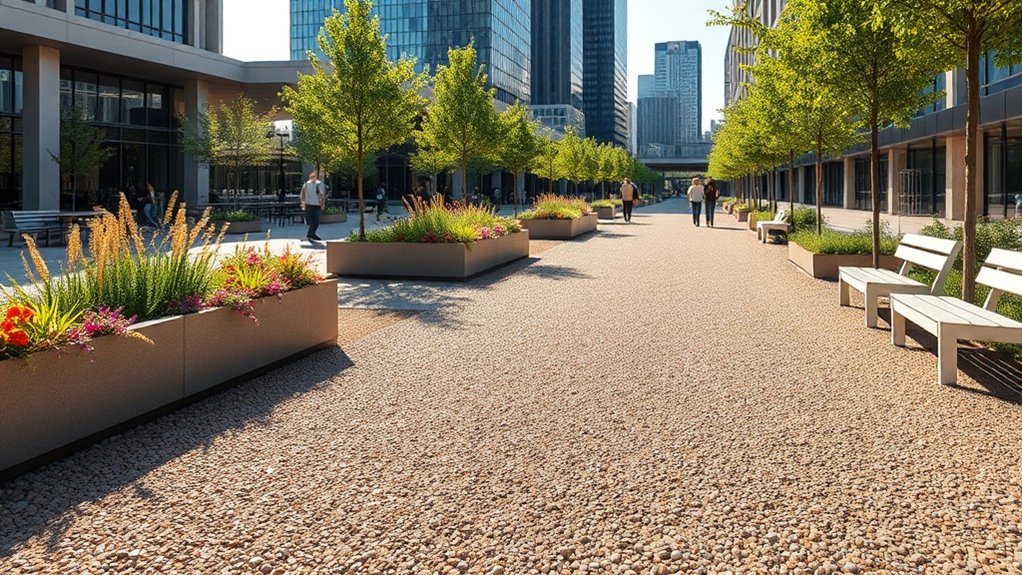
In urban design, the aesthetic flexibility of resin-bound gravel is a valuable asset for customisation. Its range of colours and textures can significantly enhance visual appeal, helping to create cohesive environments that blend tradition with modernity. For instance, using this material in pathways or public spaces can unify different architectural styles and landscape features, making areas feel more connected and inviting. Additionally, the robust, permeable pavement provided by resin-bound gravel promotes water drainage, contributing to sustainable landscapes. Its ability to reduce trip hazards further solidifies resin-bound gravel as an ideal choice for public spaces frequented by diverse groups of people.
Customizable Design Options
Customisable design options for resin-bound gravel provide urban planners with a fantastic range of choices to enhance both the look and functionality of public spaces.
With numerous colour options available, you can easily complement different architectural styles, from Victorian to modern. The variety of textures—such as stone and recycled materials—not only offers unique finishes but also improves slip resistance, ensuring safety in urban areas. Additionally, the use of natural aggregates in resin-bound surfaces ensures that these designs align with eco-friendly practices, enhancing sustainability. Furthermore, permeable design contributes to natural water management, reducing urban runoff and promoting eco-friendliness within these public spaces.
This flexibility allows for easy integration into complex shapes and contours, making it ideal for everything from narrow paths to expansive plazas. Opting for lighter colours can also help mitigate urban heat islands.
Ultimately, these choices enable you to create distinctive, practical spaces that reflect community character while supporting sustainable practices.
Enhanced Visual Appeal
Resin-bound gravel significantly boosts the visual appeal of urban areas, combining functionality with aesthetic charm. Its durability and variety of colours ensure visual consistency, making it a top choice for urban designers.
| Feature | Benefit |
|---|---|
| Colour Variety | Complements diverse landscapes |
| Durability | Preserves visual appeal over time |
| Permeability | Promotes healthy urban green spaces |
In essence, resin-bound gravel not only looks good but also lasts, making it ideal for enhancing urban environments.
Integrative Urban Aesthetics
Urban designers are increasingly aware of the need to blend aesthetics with functionality in public spaces.
Resin-bound gravel is an excellent choice in this regard, available in a range of colour finishes that suit various urban settings, from historic sites to contemporary developments. Its smooth, attractive surface not only enhances visual appeal but also offers a durable, permeable pavement solution.
This material complies with Sustainable Urban Drainage Systems (SUDS) and supports green infrastructure, helping to reduce urban runoff.
With options for customisation, resin-bound surfaces can be tailored to meet specific design objectives, improving both kerb appeal and practicality.
Maintenance and Cost-Effectiveness
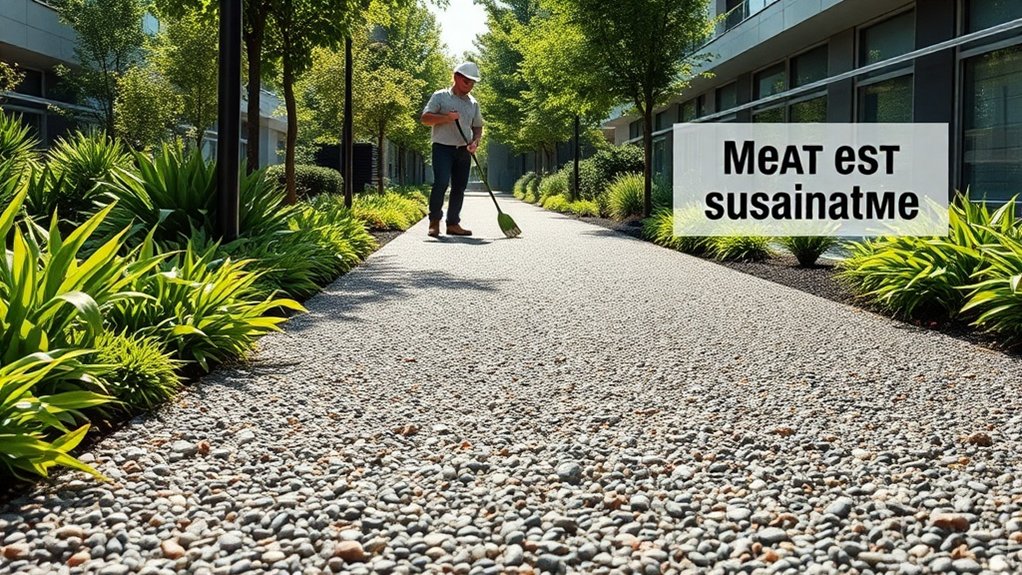
When it comes to resin-bound gravel, you’ll find it remarkably low-maintenance, which can significantly cut your annual upkeep costs.
With proper care, this durable material can last over 20 years, reducing the need for repairs. This makes it a practical financial choice and supports sustainable urban development.
Low Upkeep Requirements
Resin-bound gravel stands out for its low upkeep requirements, making it an ideal option for urban planners. Its time-saving nature allows you to concentrate on other development aspects without the constant worry of maintenance.
Here are some simple upkeep strategies:
- Regular sweeping with a stiff brush to prevent debris from accumulating.
- Jet washing once or twice a year, with natural rain helping to clean as well.
- Quick removal of organic matter to prevent staining and keep it looking good.
- Routine inspections to catch minor issues early, ensuring it stays in top condition.
These straightforward methods not only make maintenance easier but also enhance the long-term viability of urban areas, making resin-bound gravel a wise investment.
Long-Term Durability Benefits
Resin-bound gravel provides remarkable long-term durability, making it an ideal choice for urban planners prioritising maintenance and cost-effectiveness.
With a lifespan of 20 to 30 years, it outlasts traditional materials like asphalt and loose gravel. Its resistance to UV rays and extreme weather ensures that surfaces remain intact, reducing the need for expensive repairs.
Maintenance is straightforward; a bit of cleaning and occasional local repairs keep the surface looking fresh. Additionally, its unique design helps prevent erosion and water damage, further cutting long-term costs.
Community Benefits
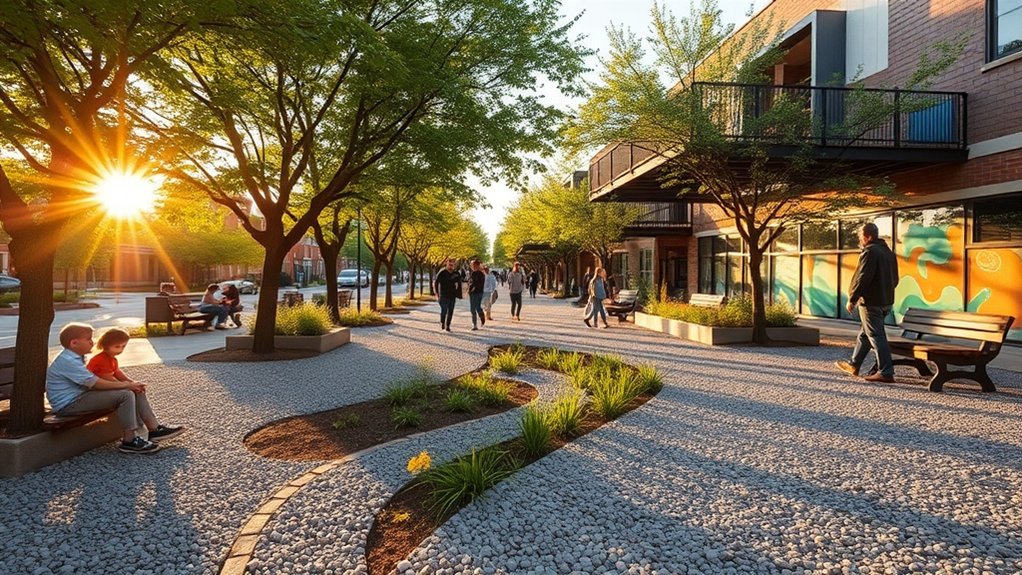
As urban planners focus more on community well-being, integrating resin-bound gravel surfaces brings notable benefits.
These surfaces foster community engagement and enhance social interaction by creating inviting public spaces. Here are four key advantages:
- Accessibility: Smooth finishes remove trip hazards, providing safe pathways for all.
- Aesthetic Appeal: Custom designs enhance local identity, making communal areas more attractive.
- Versatility: These adaptable surfaces accommodate various activities, from parks to event spaces.
- Environmental Awareness: Sustainable infrastructure builds community pride and encourages eco-friendly practices.
Health and Safety Advantages

Integrating resin-bound gravel in urban areas not only boosts community engagement but also significantly enhances health and safety.
This material offers a textured, non-slip surface that effectively prevents slips, especially in wet or icy conditions, thereby reducing accidents. The secure bonding of the aggregate prevents loose stones, eliminating common trip hazards.
Notably, resin surfaces meet safety standards by over 40%, making them suitable for high-risk areas like footpaths and wheelchair ramps. Their permeable design allows for efficient water drainage, which helps prevent standing water and ice.
Plus, the durable surface resists weed growth and is easy to maintain, ensuring ongoing safety. Overall, resin-bound gravel improves accessibility while prioritising user safety.
Economic and Developmental Benefits
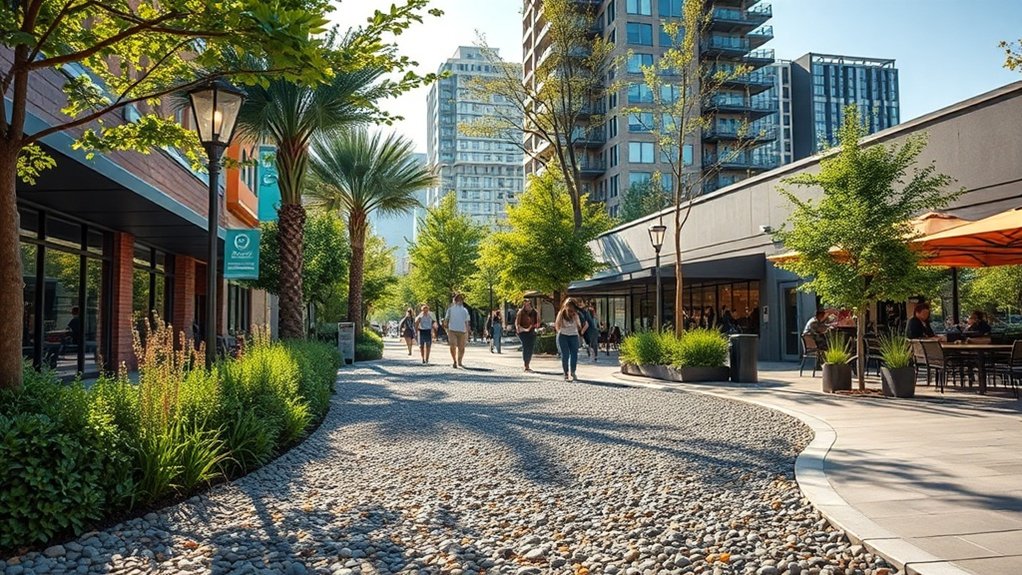
As urban planners explore new ways to improve city landscapes, resin-bound gravel stands out for its economic and developmental benefits. This material not only supports economic growth but also enhances urban resilience.
Here are four key advantages:
- Cost Efficiency: Its long-lasting nature cuts down on repair and maintenance costs, freeing up funds for other priorities.
- Increased Property Value: A more attractive appearance boosts market appeal, drawing in investment to urban areas.
- Regulatory Compliance: It adheres to SUDS regulations, simplifying development processes and making it easier to access grants.
- Community Engagement: Well-designed urban spaces encourage foot traffic, which in turn stimulates local businesses.
Investing in resin-bound gravel can lead to sustainable and vibrant urban environments that thrive both economically and socially.
Stormwater Management Capabilities
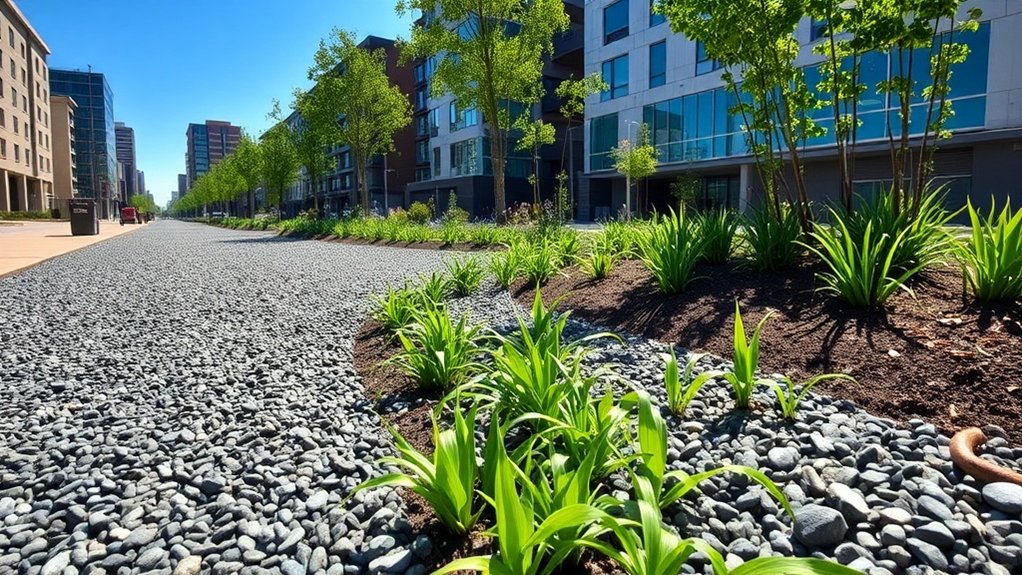
When it comes to stormwater management, resin-bound gravel provides an effective natural drainage solution by allowing rainwater to seep through its surface.
This design helps reduce runoff and plays a key role in minimising pollution, as the gravel naturally filters the water before it reaches the groundwater.
Natural Drainage Solutions
Resin-bound gravel is an essential element in natural drainage solutions, helping to manage stormwater and improve urban resilience. Its permeable surface effectively reduces flood risk by allowing rainwater to drain away, which lessens the burden on drainage systems.
Here are the main benefits of resin-bound gravel:
- Flood Risk Reduction: Water seeps through, reducing pooling and surface runoff.
- High Drainage Capacity: Can handle 850-1000 litres per square metre per hour.
- Groundwater Recharge: Aids natural water cycles, replenishing local aquifers.
- Erosion Prevention: Minimises water stagnation, reducing potential damage.
Using resin-bound gravel is a practical choice for sustainable urban development.
Pollution Mitigation Strategies
As urban areas grapple with stormwater management and pollution, effective pollution mitigation strategies are crucial.
Resin-bound gravel stands out by offering a permeable surface that filters harmful chemicals from rainwater, preventing contamination of groundwater. This not only protects vital water resources but also aids in their replenishment.
Complying with Sustainable Urban Drainage Systems (SUDS) requirements, resin-bound gravel efficiently manages stormwater runoff and reduces flooding risks. Its durability and low maintenance make it a sensible choice for long-term stormwater management, helping urban spaces thrive while protecting the environment and boosting community resilience against pollution.
Customization Options for Unique Designs
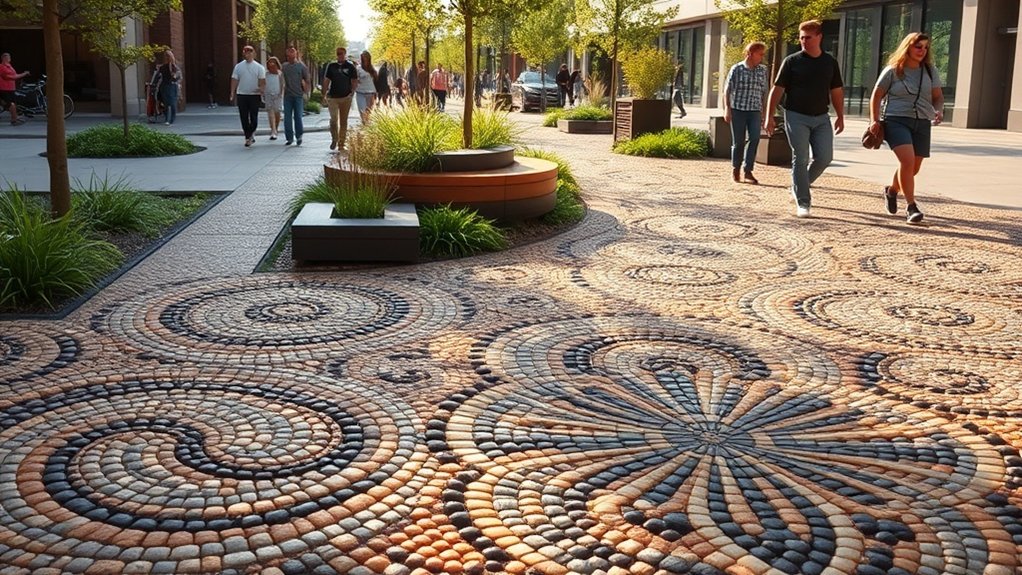
How can customisation enhance the aesthetic and functional appeal of urban spaces? By utilising bespoke designs and vibrant aggregates, you can craft unique environments that embody community identity.
Here are four key customisation options:
- Colour Variations: Select from a broad spectrum of stone colours and mixes, including natural hues or lively aggregates, to align with branding or thematic goals.
- Patterns and Shapes: Introduce geometric patterns or decorative borders to create structured layouts that boost visual interest.
- Material Combinations: Combine resin-bound gravel with materials like timber or stone for added contrast and character.
- Commercial Customisation: Feature logos or tailored designs in commercial spaces, reinforcing branding while prioritising safety with slip-resistant options.
Long-Term Value and Durability
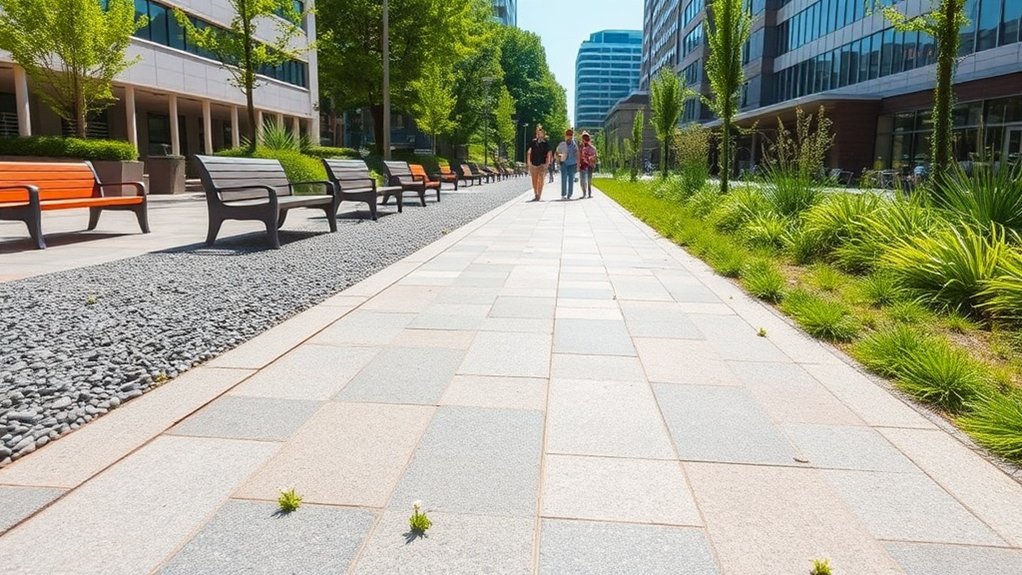
When it comes to urban planning, understanding the long-term value and durability of resin-bound gravel is essential. This material is a worthwhile investment, lasting over 20 to 30 years with proper installation and maintenance.
Compared to traditional gravel and tarmac, resin-bound gravel stands out for its durability, offering a seamless, flexible surface that resists cracking and erosion. Its UV-stable composition contributes to its longevity, and it requires minimal upkeep, keeping maintenance costs low.
Regular inspections and prompt repairs can further extend its life. With the ability to endure extreme weather and heavy traffic, resin-bound gravel not only boosts aesthetic appeal but also ensures safety, making it a smart choice for sustainable urban development.
Compliance With Sustainable Urban Regulations
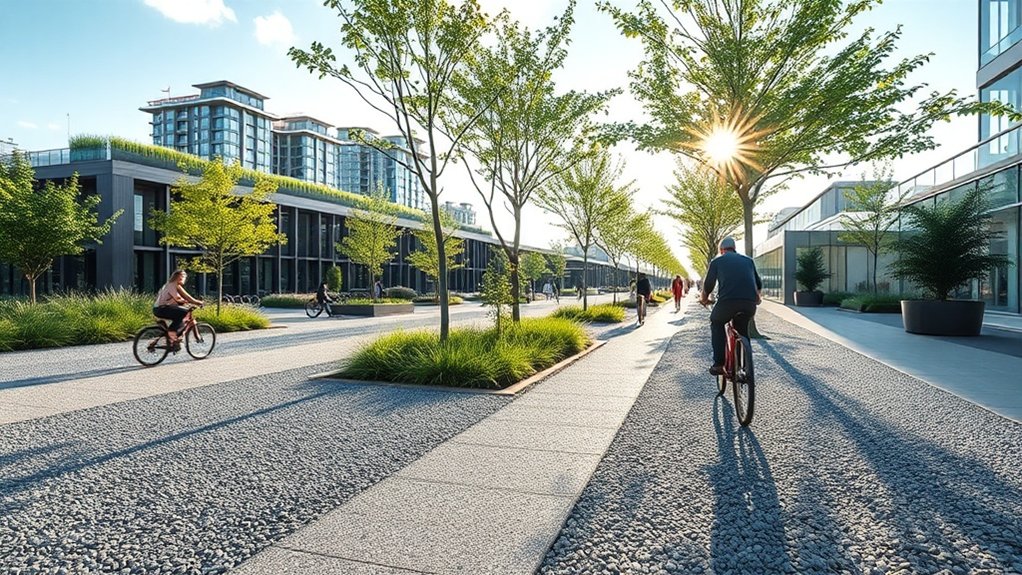
To ensure compliance with sustainable urban regulations, it’s important to consider the benefits of resin-bound gravel as a permeable surface option. This material not only meets the requirements of Sustainable Urban Drainage Systems (SUDS) but also helps to reduce urban flooding.
Here are four main advantages:
- Permeability: Resin-bound gravel allows rainwater to drain away naturally, helping to lower the risk of flooding.
- Regulatory Preference: Local councils often favour permeable surfaces, which can simplify the planning permission process.
- Planning Exemptions: Generally, surfaces under 5 square metres don’t require planning permission, making installation easier.
- Environmental Compliance: This material adheres to legal water management regulations and provides ecological benefits.
Frequently Asked Questions
How Does Resin-Bound Gravel Compare to Traditional Paving Materials?
Resin-bound gravel is a cost-effective alternative to traditional paving materials, offering both aesthetic appeal and practical advantages. It is durable, requires minimal maintenance, and can be customised to fit various designs. For instance, it’s ideal for driveways and pathways, enhancing the look of urban areas while being a smart choice for homeowners and businesses alike.
Is Resin-Bound Gravel Suitable for All Climates?
Yes, resin-bound gravel is well-suited for a range of climates in the UK. It can handle both scorching summers and frosty winters, ensuring it remains durable and functional throughout the year. This makes it a smart choice for various weather conditions, whether you’re in the south where it can get quite warm, or in the north where temperatures drop significantly.
What Is the Installation Process for Resin-Bound Gravel?
The installation process for resin-bound gravel is straightforward, though it requires attention to detail. Begin by excavating the area to the appropriate depth. Next, lay a stable sub-base, which could be crushed stone or a similar material. After that, mix the resin and aggregate thoroughly. Finally, apply the mixture evenly across the surface and allow it to cure properly. This method ensures a durable and attractive finish for driveways or pathways.
Can Resin-Bound Gravel Be Installed Over Existing Surfaces?
Yes, you can install resin-bound gravel over existing surfaces. Just ensure you prepare the surface properly by cleaning and patching any imperfections. This helps create a stable bond, reducing the risk of issues with the overlay later on. For instance, if you’re laying it over concrete, make sure the concrete is clean and free of cracks before applying the resin-bound gravel.
How Long Does Resin-Bound Gravel Last Before Needing Replacement?
Resin-bound gravel generally lasts between 15 and 30 years, depending on factors like quality and maintenance. With proper care, such as resealing every five years, you can significantly prolong its lifespan, ensuring you get good value for your investment.
Conclusion
Consider the many benefits of resin-bound gravel in sustainable urban planning. This material not only offers environmental advantages but also enhances the look of spaces and strengthens communities. Imagine transforming public areas or driveways into attractive, functional environments that support healthier living. Its durability and ability to manage stormwater effectively can make a real difference in urban settings. Will you choose to adopt this innovative solution and help create a more sustainable future?
